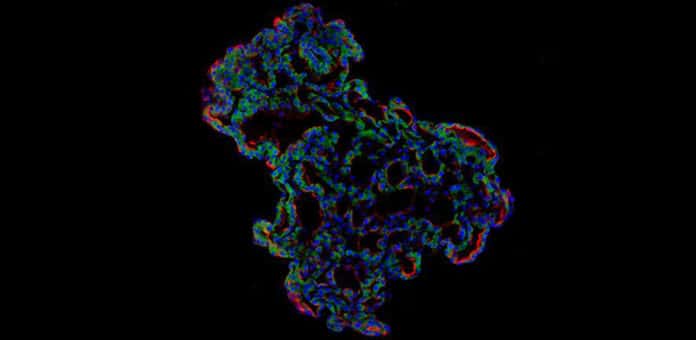How SARS-CoV-2 infects the lungs and cause disease?
To get a better understanding of this, scientists from the UK and South Korea turned to organoids. Organoids are tiny, self-organized three-dimensional tissue cultures that are derived from stem cells.
Using the tissue donated to tissue banks, scientists extracted a type of lung cell known as human lung alveolar type 2 cells. By reinventing these cells back to their earlier ‘stem cell’ stage, they had the option to develop self-organizing alveolar-like 3D structures that mimic key lung tissue conduct.
This approach allowed scientists to grow 3D models of crucial lung tissue – in a sense, ‘mini-lungs’ – in the lab and study what happens when they become infected.
During this study, scientists infected the organoids with a strain of SARS-CoV-2 taken from a patient in South Korea diagnosed with COVID-19 on 26 January 26, 2020. They then used a combination of fluorescence imaging and single-cell genetic analysis to study how the cells responded to the virus.
They observed that the virus started replicating rapidly after the 3D models were exposed to SARS-CoV-2. It took just 6 hours to reach the full cellular infection. Replication enables the virus to spread throughout the body, infecting other cells and tissue.
Simultaneously, the cells started producing interferons – proteins that act as warning signals to neighboring cells, telling them to activate their antiviral defenses. After 48 hours, the interferons triggered the innate immune response – its first line of defense – and the cells started fighting back against infection.
After 60 hours of infection, a subset of alveolar cells started disintegrating, causing cell death and lung tissue damage.
Scientists observed changes to the lung cells within three days of infection; clinical symptoms of COVID-19 rarely occur quickly and can sometimes take more than ten days after exposure to appear.
They noted, “there are several possible reasons for this. It may take several days for the virus, first infiltrating the upper respiratory tract to it reaching the alveoli. It may also require a substantial proportion of alveolar cells to be infected or for further interactions with immune cells resulting in inflammation before a patient displays symptoms.”
Dr. Young Seok Ju, co-senior author, and an Associate Professor at Korea Advanced Institute of Science and Technology said, “Based on our model we can tackle many unanswered key questions, such as understanding genetic susceptibility to SARS-CoV-2, assessing relative infectivity of viral mutants, and revealing the damage processes of the virus in human alveolar cells. Most importantly, it provides the opportunity to develop and screen potential therapeutic agents against SARS-CoV-2 infection.”
Dr. Joo-Hyeon Lee, co-senior author, and a Group Leader at the Wellcome-MRC Cambridge Stem Cell Institute, University of Cambridge, said, “We hope to use our technique to grow these 3D models from cells of patients who are particularly vulnerable to infection, such as the elderly or people with diseased lungs, and find out what happens to their tissue.”
The research involved scientists from the University of Cambridge, UK, and the Korea Advanced Institute Science and Technology (KAIST), Korea National Institute of Health, Institute for Basic Science (IBS), Seoul National University Hospital, and GENOME INSIGHT Inc. in South Korea.
Journal Reference:
- Jeonghwan Youk et al. Three-dimensional human alveolar stem cell culture models reveal infection response to SARS-CoV-2. Cell Stem Cell; 21 Oct 2020; DOI: 10.1016/j.stem.2020.10.004
